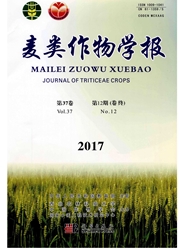

 中文摘要:
中文摘要:
为了明确弱春性高产小麦新品系J210对早播的适应性以及为早播早熟型超高产品种的选育提供依据,2006-2007年在四川盆地气候生态条件下研究了不同程度早播(从10月18日到11月5日每2d一个播期,共10个播期)对J210生育进程、籽粒灌浆特性和产量及产量构成的影响。结果表明,J210的生育进程随播期的提前而提前,全生育期和灌浆持续期随播期的提前而增长;110月18—30日间播种,单位面积穗数和粒数变化不明显,籽粒平均灌浆速率差异也很小,但粒重随播期推迟而降低。而10月30日之后播种,单位面积穗数和粒数明显减少,籽粒灌浆速率和粒重随播期推迟而增高;从产量看,以10月18日播种最高,但在10月28日之前播种减产不显著,在10月28日之后播种显著减产,10月18日播种比11月5日播种增产达29.92%。考虑到试验期间为暖冬年,认为J210在生产上的高产而又安全的播期为10月25日左右。在进行更加高产的早播早熟型小麦品种选育时,可将育种材料的播期提前到10月20日左右,这样有利于育成更加适应早播的高产稳产小麦新品种。
 英文摘要:
英文摘要:
The rotation of winter wheat (Triticurn aestivum L.) and rice (Oryza sativa) is the prevailing double-cropping system in the Sichuan Basin. Typically, winter wheat is sown at early November and harvested at the middle ten days of May. Rice is sown at early April and rice seedlings are transplanted into the field immediately after harvesting of wheat, then rice are harvested from the last ten days of August to the first ten days of September. So the field is vacant in September and October, and the sun radiation is wasted in this period. Furthermore, the winter wheat is with risks of high temperature during the postheading period. Thereby, to put ahead the sowing date and the harvest time of winter wheat will utilize more sun radiation and achieve higher grain yield. So we must develop new wheat varieties fitting for being sowed and harvested earlier (NWVFSHE). In this study, the trial was carried out to investigate the effect of sowing dates on growth and development, grain filling characters and yield of winter wheat in Sichuan Basin in the season of 2006-2007 to provide references for breeding the NWVFSHE and to determine the suitable sowing date of J210. There were ten sowing dates from 18th October to 5th November. The results showed that the development stages were put ahead in earlier sowing dates. The difference in the heading dates and the flowering dates was the same as that in sowing dates and the difference in maturating dates was less than that in the sowing dates, so the growth period and the grain filling duration of earlier sowing treatment were longer than that of later sowing treatment. The average grain filling rate and the kernels number of unit area were similar in different sowing dates, so the grain weight and the yield were determined by the grain filling duration. Therefore the yield of wheat sowed on 18th October was 29.92 more than that of wheat sowed on 5th November. So the NWVFSHE can adapt perfectly to the ecology and climate and the cropping system in Sichuan Basin and ob
 同期刊论文项目
同期刊论文项目
 同项目期刊论文
同项目期刊论文
 Production of a new wheat cultivar with a different 1B.1R translocation with resistance to powdery m
Production of a new wheat cultivar with a different 1B.1R translocation with resistance to powdery m Variations of tandem repeat, regulatory element, and promoter regions revealed by wheat-rye amphiplo
Variations of tandem repeat, regulatory element, and promoter regions revealed by wheat-rye amphiplo Stripe rust (Puccinia striiformis f. sp. tritici) resistance in wheat genotypes with 1RS chromosomal
Stripe rust (Puccinia striiformis f. sp. tritici) resistance in wheat genotypes with 1RS chromosomal 期刊信息
期刊信息
